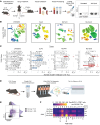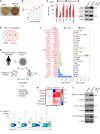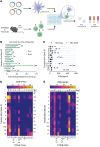DNA-PK inhibition enhances neoantigen diversity and increases T cell responses to immunoresistant tumors
- PMID: 39436696
- PMCID: PMC11645140
- DOI: 10.1172/JCI180278
DNA-PK inhibition enhances neoantigen diversity and increases T cell responses to immunoresistant tumors
Abstract
Effective antitumor T cell activity relies on the expression and MHC presentation of tumor neoantigens. Tumor cells can evade T cell detection by silencing the transcription of antigens or by altering MHC machinery, resulting in inadequate neoantigen-specific T cell activation. We identified the DNA-protein kinase inhibitor (DNA-PKi) NU7441 as a promising immunomodulator that reduced immunosuppressive proteins, while increasing MHC-I expression in a panel of human melanoma cell lines. In tumor-bearing mice, combination therapy using NU7441 and the immune adjuvants stimulator of IFN genes (STING) ligand and the CD40 agonist NU-SL40 substantially increased and diversified the neoantigen landscape, antigen-presenting machinery, and, consequently, substantially increased both the number and repertoire of neoantigen-reactive, tumor-infiltrating lymphocytes (TILs). DNA-PK inhibition or KO promoted transcription and protein expression of various neoantigens in human and mouse melanomas and induced sensitivity to immune checkpoint blockade (ICB) in resistant tumors. In patients, protein kinase, DNA-activated catalytic subunit (PRKDC) transcript levels were inversely correlated with MHC-I expression and CD8+ TILs but positively correlated with increased neoantigen loads and improved responses to ICB. These studies suggest that inhibition of DNA-PK activity can restore tumor immunogenicity by increasing neoantigen expression and presentation and broadening the neoantigen-reactive T cell population.
Keywords: Adaptive immunity; Antigen presentation; Cancer immunotherapy; Immunology; Oncology.
Figures






References
MeSH terms
Substances
Grants and funding
LinkOut - more resources
Full Text Sources
Medical
Research Materials

